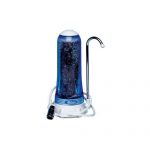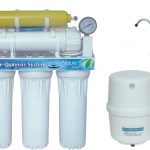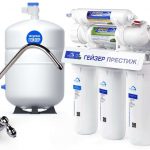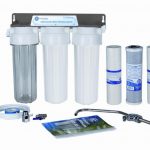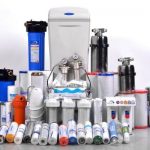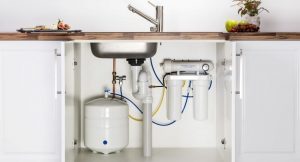 In addition to pathogenic bacteria and harmful chemical impurities, running water may contain metal salts, large particles of rust or mud. To be sure of the purity of the consumed water, health experts recommend the use of special filters. They will help get rid of debris, dangerous trace elements and allergens. How to choose a filter for washing and what are the advantages of this design?
In addition to pathogenic bacteria and harmful chemical impurities, running water may contain metal salts, large particles of rust or mud. To be sure of the purity of the consumed water, health experts recommend the use of special filters. They will help get rid of debris, dangerous trace elements and allergens. How to choose a filter for washing and what are the advantages of this design?
Content
Features of filters for water purification with placement under the sink
The main feature of such filters is the name. The cleaning system is connected directly to the water pipes that are located under or next to the kitchen sink. For installation, special connectors and mounts are used, sold complete with a filter. Purified water can be discharged through the main or additional faucet on the sink (or near it).
If under the sink there is not enough space for installation, you can fix the stationary device on the wall using an elastic eyeliner. The purified water will be discharged in the same way as with a standard connection. Now we will discuss the advantages and disadvantages of treatment systems installed under the sink:
Benefits:
- Permanent access to clean water, unlike stand-alone devices;
- It can be installed not only in the kitchen, but also in any other room with access to water supply;
- Universal replaceable cartridges;
- Simple design that is easy to install;
- Advanced multi-stage water filtration system that removes all harmful trace elements;
- The filter is installed under the sink and becomes invisible to others;
- No need to change cartridges so often.
Disadvantages:
- Compared to other types, a more time-consuming installation process;
- Not suitable for homes with low water pressure;
- Higher cost due to the presence of additional mounts in the kit;
- Needs cleaning and periodic replacement of used reagents;
- Some types of filters do not cope with full cleaning;
- Only suitable for rooms with access to water supply.
Despite the obvious drawbacks, the filters for water purification installed under the sink do much better with water purification than other devices. They are versatile and practical to use.
Principle of operation
The filter installed under the sink consists of two, three or four replaceable cartridges (or membranes). The first cartridge traps large particles of debris (dirt, corroded iron, etc.), the second cartridge purifies water from smaller impurities and / or harmful bacteria (antibacterial, anti-allergenic), and the third softens the water, removing metal residues. The principle of operation is simple: water flows through the pipe and enters the filter, where all stages of treatment pass in turn. As a rule, after installing the system, the pressure becomes weaker.
It makes no sense to buy multi-stage systems if the water is simply oversaturated with iron. This applies to ordinary apartments or office premises. Sooner or later you will have to change the cartridges for new ones, but they are not cheap. Mechanical filters and softeners are considered necessary. But if you live in a country house or village, where there are often problems with a well, multi-stage cleaning is really useful.
Kinds
There are many models of filters installed under the sink. All of them can be divided into two categories - flow-through and reverse osmosis systems.They differ from each other in the principle of water purification. And now in more detail:
- Flowing filters for water purification. They are several small tanks interconnected. They insert replaceable cartridges with different fillers. As already mentioned, cartridges can be from two to four. Such devices are connected to the water supply using elastic mounts. Water flows through a small additional faucet, which is installed next to the main one. Here are the main types of cartridges for cleaning: sorption (protect water from bleach and unpleasant odors), ion exchange (make water less rigid by attracting metals), polypropylene (remove large particles, such as sand or rust), combined (cartridge that combines several types of processing).
- Reverse osmosis systems. The principle of operation of such devices is to pass water through special membranes with different pore sizes. Most such systems have at least three membranes for cleaning. They trap all foreign particles regardless of size. The last membrane has the smallest openings through which only water molecules can pass. All minerals and useful elements also remain on the filter. As a result - distilled water without any impurities, which will not bring you any harm or benefit.
It’s hard to say which of these systems is better. For hard water, you should choose reverse osmosis, because the ion exchange cartridge cannot completely get rid of the problem. It is also worth giving preference to this system if you have any kidney disease. For all other cases, conventional flow filtration is suitable.
How often do filters need to be changed?
For flowing devices, cartridges should be replaced after 3-6 months of active use. It depends not only on the model and manufacturer, but also on the volume of water passed through. If the consumption is large, then the service time is reduced. The same goes for water quality. If it is too stiff or has a lot of impurities, the filters will have to be changed more often.
Reverse osmosis systems are much less likely to need to be replaced - only 1 time in 1.5-2 years. However, they must be periodically cleaned of accumulated debris, as pressure may weaken. The amount of water allowed does not affect the rate of pollution too much. Normal is considered to be from 170 liters per day and above.
average cost
Flowing devices are cheaper than osmosis systems - from 2 to 7 thousand rubles, but require a more frequent change of cartridges - from 300 to 600 rubles apiece. Prices for reverse osmosis systems start from 7 thousand rubles, and the cost of one membrane - from 1.2 thousand rubles. Despite the significant difference, osmosis systems are still more cost-effective, given the service life.
How to choose a filter for installation under the sink
The water filter for washing is a universal solution, since it does not take up much space and is suitable for any kitchen or bathroom. When choosing, it is worth considering not only the name of the manufacturer, but also the amount of pressure, productivity, degree of cleaning, dimensions, scope, as well as the cost of replaceable cartridges. Here are some tips to help you buy a durable and high-quality device:
- Inlet water pressure. There is no difference in which type of water supply in your home is centralized or autonomous. For effective operation of the device, an incoming pressure of at least 2.5 atm is necessary. If it is slightly lower, then the device will not be able to provide normal cleaning. If there are problems with pressure, it is better to use reverse osmosis systems with an additional pump.
- Filter performance. When buying, pay attention to the permissible volume of water passing through. It is indicated in the technical specifications of the device. For a large family, purified water is always necessary. Better choose devices with higher bandwidth.
- Degree of purification. Regardless of the type of treatment system, water passes several stages of filtration at once.In the case of a flow filter, cartridges with different fillers are used. In reverse osmosis systems, replaceable membranes act as a filter. For urban apartments, a conventional mechanical filter and softener will suffice. Pay attention to the cost of the cartridges so that their replacement in the future does not cost too much.
- Sizes of filter and sink. For a successful device selection, it is necessary to know the type of sink and the area of free space for installation. Standard sinks are best suited.
- Destination. In order for the filter to work as efficiently as possible and not cause harm, when choosing it is necessary to take into account the main problems of the water used. It is best to conduct a chemical examination for this. For example, a flow filter is not suitable for very hard water, because he can only partially mitigate it.
It is also worth paying attention to the warranty period. With good filters for drinking water, it is three to four years.
Rating of the best filters for sinks
Choosing a quality filter without the help of a specialist can be quite difficult. We have compiled a rating of the best devices for 2019 based on user reviews and ratings. Here are the top 5 cleaning systems installed under the sink:
Akvafor OSMO 50 execution 5
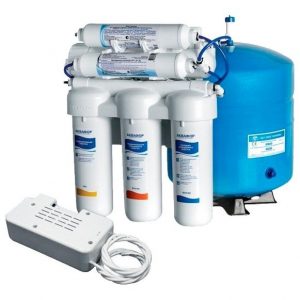
- Type of device: filter with reverse osmosis system
- Placement: under the sink
- Filtration System: 5 steps
- Filtration technologies: reverse osmosis, carbon filter
- Water temperature: cold
- Additional water tank: yes, with a volume of 10 l
- Productivity: 0.13 L / min
- Output pressure: from 3.50 atm to 6.50 atm
- quickly installs;
- reasonable price, in comparison with other models;
- TDS is always at level 10.
- very short hose for the crane;
- low quality plastic;
- difficult instruction.
Atoll A-550m STD

- Type of device: filter with reverse osmosis system
- Placement: under the sink
- Filtration System: Five Step
- Filtration technologies: reverse osmosis, carbon filter
- Water temperature: cold
- Purpose: water softening, chlorine removal, mineralization
- Conclusion: with tap
- Built-in water tank: yes, with a volume of 12 l
- Productivity: 0.08 L / min
- Output pressure: from 2.80 atm to 6 atm
- high-quality components;
- large tank of 12 liters;
- easy to put on;
- there is a mineralization function.
- ill-conceived drainage system;
- takes up a lot of space under the sink;
- it’s difficult to open the splice and replace the membrane.
Expert Osmos MO600
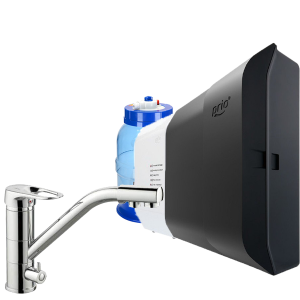
- Type of device: filter with reverse osmosis system
- Placement: under the sink
- Filtration System: Five Step
- Filtration technologies: reverse osmosis, carbon filter
- Water temperature: cold
- Purpose: water softening, chlorine removal, mineralization
- The crane for an output: is
- Pump to increase the outlet pressure: yes
- Additional water tank: yes, with a volume of 7.5 l
- Productivity: 0.2 L / min
- Output pressure: from 0.50 atm to 4.20 atm
- transparent tank;
- there is a mineralizer;
- there is a pump to increase pressure;
- the presence of self-diagnosis.
- characteristic "growl" after opening the tap.
Praktic Osmos Stream OUD600
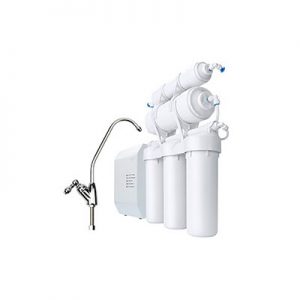
- Device type: direct-flow split system with osmosis
- Placement: under the sink
- Filtration system: six-speed
- Filtration technologies: reverse osmosis, carbon filter
- Water temperature: cold
- Purpose: water softening, chlorine removal, mineralization
- The crane for an output: is
- Additional functions: electronic control of the system, automatic flushing of the membrane, light indication
- Pump to increase the outlet pressure: yes
- Productivity: 1.25 L / min
- Output pressure: from 3 atm to 11 atm
- there is an auto-wash after each use;
- removes any unpleasant odors;
- economically consumes water, with minimal discharge into the sewer;
- compact.
- not found.
PROFI Osmo 100 barrier
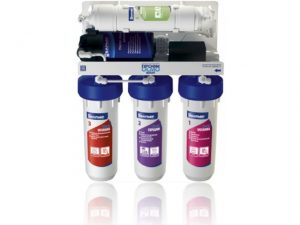
- Device type: reverse osmosis filter
- Placement: under the sink
- Filtration System: Three Stage
- Filtration technologies: reverse osmosis, carbon filter
- Appointment of the device: water softening, chlorine removal
- Water temperature: cold
- Additional water tank: yes, with a volume of 8 l
- Productivity: 0.2 L / min
- Output pressure: from 3 atm to 7 atm
- inexpensive;
- convenient installation;
- the presence of a storage tank for water;
- non-original replaceable filters can be used.
- sometimes there is a white coating on the dishes, as the filter contains calcium carbonate.
Output
Filters for washing are designed for instant cleaning of water from harmful impurities. Not only the taste of the prepared dishes, but also the health of loved ones depends on the quality of the water. Do not save on wastewater systems. In the direct-flow filter market, both foreign and domestic companies compete. It is better to give preference to trusted manufacturers who have many positive reviews about their work. Despite the overpriced cost of direct-flow cleaning systems, they are much more cost-effective than the same filter jugs or coolers.
